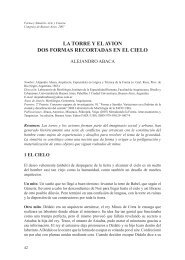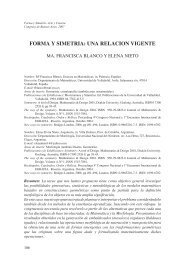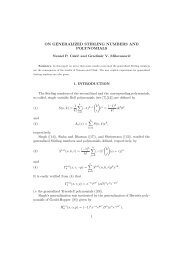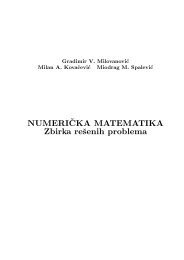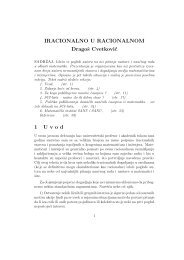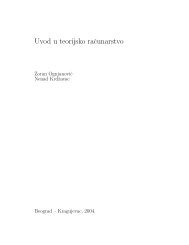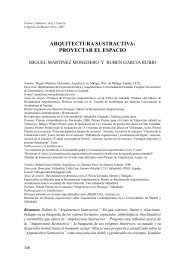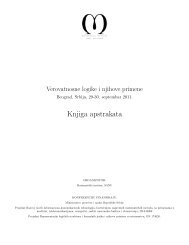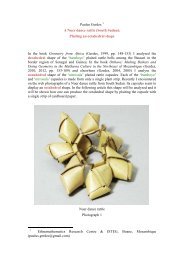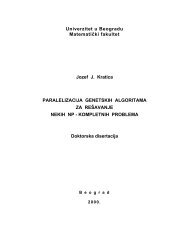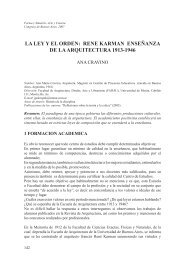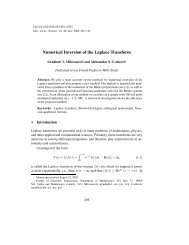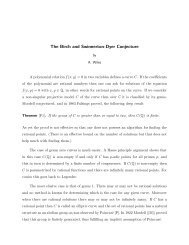A BRIEF SURVEY OF FRAMES FOR THE LAMBEK CALCULUS
A BRIEF SURVEY OF FRAMES FOR THE LAMBEK CALCULUS
A BRIEF SURVEY OF FRAMES FOR THE LAMBEK CALCULUS
- No tags were found...
You also want an ePaper? Increase the reach of your titles
YUMPU automatically turns print PDFs into web optimized ePapers that Google loves.
186 LDOSENToAI-A,AoTI-A,AI-ToA,AI-AoT.The sequents A I- A 0 (B+ B) and (B- B)d A I- A are provable in L,,,,and a fortiori in ktand L. (That the second sequent is provable in a system that amounts to L,, was noted inBUSZKOWSK~ [6], 4.2.)Let now L, be I., L,, or La, and let us consider how we could formulate the (0, +, +)fragment of L. Gentzen-type sequent formulations of this fragment, which may also be cutfree,can easily be constructed by proceeding as in [8]. Via these Gentzen formulations wecan show that a Hilbert-type axiomatization of all formulae A of P (i.e. formulae in the connectives0, + and +) such that T I- A is provable in L may be obtained from our axiomatizationof L, by replacing every I- in the axiom-schemata and rules by + and adding therulesA+B B+A A A+BB+A’ A+B’ BWith this Hilbert-type axiomatization we have a rather good control over the (0, +, +) fragmentof L, since A t- B is provable in & iff T I- A+ B is. But, of course, if T I- C is provablein L,, then C is not necessarily of the form A+B (or B+A); for example, we canprove T I- (C1+ C,) 0 (C2- CJ in L,. An axiomatization of the (0, +, +) fragment ofgiven uniquely for sequents of the form A I- B may be obtained by extending L, with therulesA I- Bh(A I- B) I- h(C1 I- 01)0 ... 0 h(CnI- On)Cit- 0;(n 2 1 ,ls is n),where h (A, I- A2) is either Al + A2 or A2 + Al , and the bracketing on the right-hand side ofthe right premise is arbitrary. This can be inferred without much dificulty from our Hilberttypeaxiomatization, for which the rulesAoB AoB A BA ’ B ’ AoBare admissible, and where A B cannot be provable if A or B is a propositional letter.We shall not go here into considering models based on our frames for L,,,,L,, and L, andfor extensions with other connectives (indications on how to proceed may be obtained fromour references). Let us only note that in models based on two-dimensional ternary frames,u(T) will be the identity relation on 0, which is included in W if W is reflexive. We leave asan open problem whether any variant of the Lambek calculus we have considered is completewith respect to a certain class of two-dimensional ternary frames.References[I] ABRUSCI, V. M., Sequent calculus for intuitionistic linear propositional logic. In: MathematicalLogic (P. P. PETKOV, ed.), Plenum Press, New York 1990, pp. 223-242.[21 VAN BENIXEM, J. Semantic parallels in natural language and computation. In: Logic Colloquium ‘87(H.-D. EBBINGHAUS et al., eds.), North-Holland hbl. Comp., Amsterdam 1989, pp. 331-375.[3] VAN BEMHEM, J., Language in action. J. Philosophical Logic 20 (1991), 225-263.[4] BIRRH<strong>OF</strong>F, G., Lattice Theory. 3rd edition. American Mathematical Society, Providence, R.I., 1967.



